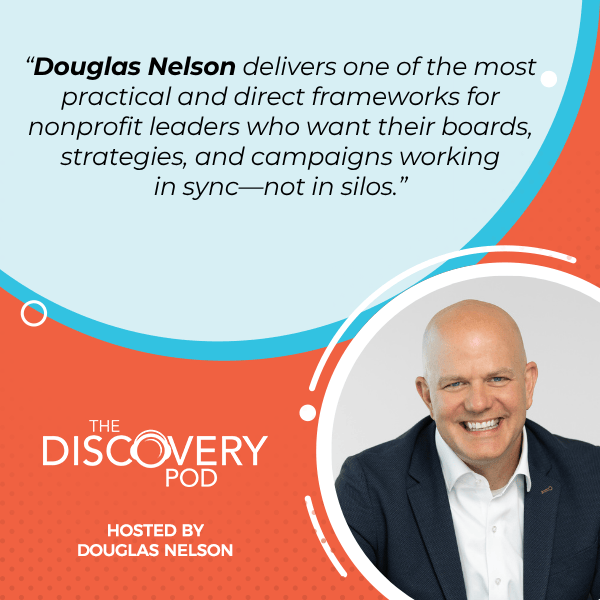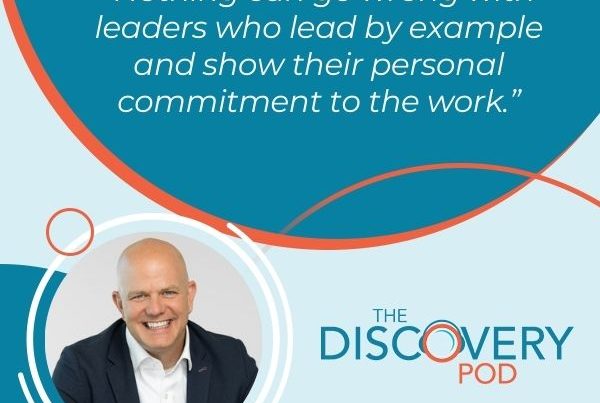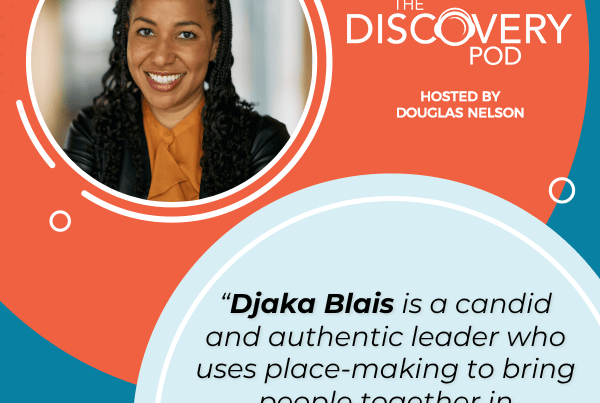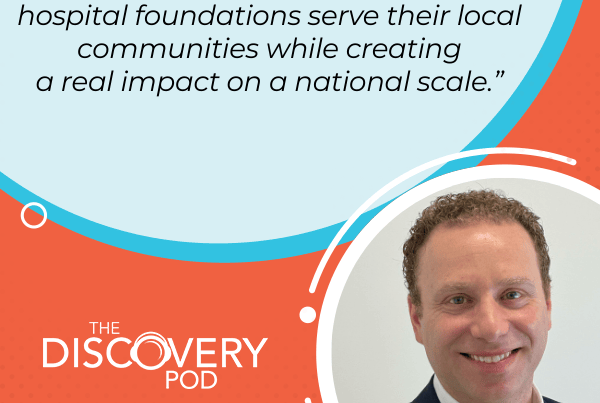
Integrating your campaign into your strategic plan isn’t just smart—it’s essential. In this season wrap-up, The Discovery Group’s very own Douglas Nelson offers a deeply practical guide for social profit leaders seeking to align campaigns, strategic planning, and board engagement. Drawing from real organizational challenges, Douglas outlines the six essential functions of exceptional boards during a campaign and shares how to activate them effectively. From centering philanthropy in your plan to avoiding campaign-case detachment and Venn diagram confusion, this episode is a masterclass in bridging purpose and fundraising with clarity.
—
Listen to the podcast here
Season 9 Wrap-Up: A Guide To Campaigns, Strategic Planning, And Board Leadership With Douglas Nelson, Host
Season 9 Wrap-Up
The end-of-season episode is usually a trip down memory lane to highlight the insights, leadership, motivation, and aspiration of the 40 guests we’ve had in the previous season. This season was no different. It was great. We had amazing leaders defying scarcity and uncertainty, steering their organizations through moments of inflection. Read these episodes if you’ve missed any.
Why Campaigns Fail Without Strategic Alignment
We know you are tuning in as unique downloads and overall listens have increased significantly. We are so pleased to be Canada’s leading social profit show. After the upheaval of the last couple of months, I wanted to do something intensely practical with this year-end episode. No speculation or theoretical insight, as valuable as those things can be, because despite it all, this sector has missions to advance, people to serve, and donors to inspire. Let’s talk about the work we need to do.
This is going to be a practical guide about an issue that we’ve heard a lot about through our work here at The Discovery Group. This is going to be the practical guide to campaigns, strategic plans, and the exceptional board’s function during the course of a campaign. We here at TDG have encountered several organizations that completely separated the conversations about strategic planning, both in the writing and in the execution, with a decision to enter into a campaign or to conduct a campaign at the same time. They were treated as though they were two perfectly separate, isolated incidents within the same organization.
In some cases, the projects or the campaign will fund or reference, but not at all. This reflects a fundamental misunderstanding of the campaign’s role in the organization-wide resources required for its success. Not every large fundraising organization or its partner organization will have a strategic plan that translates well into a case for support. It’s not a matter of taking the strategic plan and making it the case for support in all cases, though there is some value in considering it.
In those instances where you don’t have a strategic plan that translates well into a case for support, look at clinical or capital plans. Look at the hiring plans for the faculties and departments to see what areas are going to be the priority for expanded or new service in the coming years. What are going to be the areas of emphasis for your organization advancing your purpose over the course of the next number of years? A couple of good examples of that in healthcare, we’re seeing a large number of regional hospitals raising money for expanded diagnostic capacity. Larger research hospitals are exploring how to include clinical trials and clinical research centers in their fundraising priorities for their campaigns.
If your organization is providing services in whatever form, the goals of those services, at least in their future form after you’ve raised the money for the campaign, must be the focus of the campaign, and at a minimum, they must be referenced. Make the effort to integrate the priorities of your organization with an understanding of how philanthropy can play a role in realizing those priorities.
As always, the long-term requires equal standing with the immediate. A good example of that is annual equipment lists in healthcare or annual awards in post-secondary can be a way to quickly start your fundraising, but ultimately act as a ceiling or as an anchor on fundraising. Don’t stay there. Don’t hang out there. That’s the subject of another episode. In all things, exceptional leaders must balance the important against the urgent. What we’ve learned over the last couple of months is that urgency can be a tyrant.
Back to strategic plans, sports, and campaigns. We work with clients on campaign planning, strategic planning, and often both. We strongly encourage the use of fundraising numbers or goals in the strategic plan. Being specific about what you’re going to raise, whether it’s through a campaign or for your annual fundraising, gets everyone to pay attention to a big number that the organization is committing to in its strategic plan. It also creates shared accountability between management and the board for the campaign’s success.
If your campaign is still in the planning phase or the quiet phase and the number is not yet set, find a way to reference the scale and scope of the campaign. Some boards are uncomfortable with putting the campaign goal in the strategic plan. Fine, but be very clear why you are avoiding it. Is it because you don’t want to commit to something? Is it because you don’t want to make it sound like the money is more important than the purpose? Regardless, knowing why you’re not putting the number in is worth a conversation. You still need to reference the role of donors and their gifts in whatever the organization is undertaking.
Philanthropy’s Central Role In Organizational Strategy
I’ve been in too many boardrooms and hotel conference centers where someone or someone wants to debate whether the campaign is a tactic, and therefore not rising to the level of the strategic plan. The argument usually goes, “We’re a governance board, not a fundraising board. We delegate fundraising to management. The campaign doesn’t fit into the strategic plan because it’s part of the organization that’s covered by the overall strategic plan.”
These someones often are very pleased to say that they are helping the organization stay at the governance level, but let me be clear. These someones are not helping the CEO. These someones are not your friends. A campaign is a means to an end, and so is your annual fundraising, your HR strategy, or your overall capacity development. Those frequently fit into strategic plans. A strategic plan that doesn’t reflect your business model, how you fund the work that you do, and what it is now or what it will be as a result of your strategic plan is doomed. If you’re using a campaign to evolve your business model, it needs to be in the main body of the text, not in the fine print.
If your strategic plan ignores your business model, it’s doomed to fail. Share on XPhilanthropy is central to organizational strategy. Neither the mission nor the vision moves forward without the resources to empower the work. We know this. We see it every day. Those of us working in the sector know how vital the resources are to make the trains move. Your campaign reflects a vital moment of inflection for your organization. It will require resources and attention over the life of the 3 to 5-year strategic plan. As an aside, please consider a 3-year plan over a 5-year plan unless you and your board are feeling particularly Soviet.
To head off confusion and reduce the likelihood of unhealthy tension in your boardroom, it’s equally critical to center the intended outcome of your campaign. The pillars of your campaign case for support, whether it’s a new building, expanded capacity, new researchers, or new services and programs, connect those outcomes to your organizational purpose. You have a virtuous circle of priorities and areas for investment in advancing the organization.
There are three significant questions that need to be answered. What will be different when the campaign is successful? Number two, what are the implications for your organization to realize success during and after the campaign? What does it mean when it works? Number three, what role is your organization asking donors to play in order to make it happen?
Understanding Board Disconnection From Campaigns
The answers to those questions should be easily gleaned from reading your strategic plan. If you can’t, you need to go back and work on your strategic plan. This is very important. I’ve seen it happen a lot. The strategic plan is treated as the purview of the board, and the campaign is viewed as the realm of management, and sometimes and in some cases, the cabinet.
There is often even a Venn diagram that shows how the strat plan and the campaign come together with a nice overlap in the center between the work of the organization and the campaign. This is dangerous to the success of both. First, there will be elements of your strategic plan that are largely, even entirely, outside the focus of your campaign.
Fundraising is not an afterthought—it’s vital to organizational strategy. Share on XThe provision of services, programs, partner relationships, some types of advocacy, any government relations work you’re doing, and even annual fundraising that supports operations are all reasonable examples of things that might not be included in your campaign that may be referenced in your strategic plan. Whenever I am presented with these Venn diagrams, I struggle with them, but I try to stay curious.
If the campaign is the big thing and we’re asking donors and volunteers to see us in a new light, step up like never before, and see our organization as the place where they can and should make a significant contribution, I wonder what donors think or what they would think if they knew the campaign was one of many priorities and not one that the board was particularly paying attention to or concerned with, at least not enough to put it in the strategic plan.
I wonder what the VP of development or the campaign director thinks. Boards that minimize the role of a campaign in the life of an institution limit the success of the campaign and the organization. Rather than a traditional Venn diagram, in my experience, a better image is of a Ukrainian nesting doll viewed from above with a campaign surrounded by the programmatic and service components of your plan.
This is not about fundraising taking priority over purpose. Fundraising is not an afterthought. It is an unfortunate detail. It is vital. Centering your campaign and your fundraising is respectful to your donors. It ensures you are raising money for your priorities and is coherent for your team. It also has another benefit that might not be obvious at first. Board engagement.
The biggest issue many of our planning clients are asking CEOs and board chairs is how we get to these motivated, initially committed, fellow travelers to pick up the challenge of leadership and engage. This isn’t a show focused on board engagement. I’m not going to get into agenda structure, meaningful CEO reports, no PowerPoint meetings, and issue exploration, but one element of board engagement relates to campaigns and strategic planning. If the current or planned campaign is not embedded in your strategic plan, it can be challenging for your board members to grasp the levers that will determine the success of the plan and ultimately your organization.

Campaign: If the campaign isn’t embedded in your strategic plan, it’s challenging for board members to grasp the levers that determine its success and, ultimately, your organization’s.
Anyone who’s been through a campaign knows what it takes, and it takes a lot. The whole organization is pulling and pushing in the same direction. By embedding your campaign with your board, you are inviting them to participate in the conversation about what the campaign is, its goals, and what it will take to be successful.
I’m not advocating for board oversight of the campaign. All fundraising results should be reported through the finance committee and not a development or a campaign committee. I’m also not saying that CEOs should seek campaign strategy advice from people who care but are not experienced or knowledgeable about campaigns or fundraising. Instead, it’s about involving your board so that they can see and understand the organizational focus required to be successful. It’s also about preparing them to be ambassadors for the campaign.
You and your team are going to be working on and thinking about the campaign at the exclusion of a lot of other things. It’s typical for CEOs to be spending greater than 60% of her time or his time on donor activity and cabinet interactions. If your board doesn’t have a window into what is required by you and your team, you can’t be surprised when they start to get antsy or even frustrated that other issues or areas aren’t getting enough attention. They’re seeing these issues or these ideas they want to have considered, and they’re not aware of or not understanding that the CEO is spending 60% of her time on something else. They’re like, “What is she up to anyway?”
What I often see is CEOs trying to keep their boards at a distance from the campaign to avoid unsolicited, context-free advice, or even worse, direct board overreach. It’s best practice to have the cabinet report to the CEO and not to the board to ensure the cabinet remains exclusively and externally focused and free of oversight in fiduciary responsibilities. That oversight in fiduciary responsibilities stays with the board and can’t be subcontracted to the cabinet. The separation of responsibilities is important, but it can be used by a busy CEO to keep the board on the sideline.
CEOs are in a tough spot. I know, I’ve been there. It’s also a spot somewhat of our own making. Trying to keep the board engaged in the organization, and at the same time, keeping them from the area that is demanding more than half of your time doesn’t work. Early on in my consulting journey, I was asked by an experienced CEO and a great fundraiser to come talk to her board about its role during the campaign period. The board’s role in campaigns. Check. I’ve got the slide deck ready.
On the day of the session, we were doing our pre-meeting touch base. She said, “I want you to give them something to do for two years while the campaign finishes. I don’t want them involved.” The board was appropriately nonplused at being offered a two-year hiatus and dry dock. They didn’t understand it. They weren’t aware of what they should be doing for the campaign, but they wanted to be doing something. They wanted to be involved. Their ideas around being involved were what were causing our hero, the CEO, to want to keep them at bay.
The campaign was eventually successful, but the CEO spent a good deal of her time managing slash causing unhealthy tension as a result of pushing the board away from the campaign. It worked, but it was much harder than it needed to be. That’s the case for a lot of organizations. There can be some confusion about the role of the board and the role of the campaign cabinet. They are different. Different jobs, different accountabilities, and different measures of success.

Campaign: Exceptional boards approve campaign plans and hold accountability across the full budget cycle.
Board members need to reflect all four roles of exceptional social profit boards, which are decider, oversight advisor, explorer, and ambassador. A cabinet member is more of an emissary with a specific message in a narrowly defined, externally-focused job. A board has a very important job to do. It can be difficult to set aside the decider role, which many board members believe to be their most important function. They want to be involved and want to be close to it. They want to be able to make decisions and understand the information in real-time in order to make those decisions.
If your campaign is not operating independently from your board, expect that door-opening, cultivation, and solicitation will slow or suffer as the specter of oversight and governance starts to creep into the conversation. This is why development or fundraising committees so frequently result in frustration and failure. Keep your board and your plan close, but not too close to the campaign. It needs to be integrated, but not controlled by. Clear? Not really.
The Six Essential Board Functions
As Frank Costanza said when he created Festivus, “There has to be a better way.” Dear readers, there is. I’m going to share the six essential functions of exceptional boards during a campaign, and then get into how to activate those functions around your board table. Here we go. Number one, exceptional boards during the course of a campaign approve the campaign plan, overall budget, and annual cost of the campaign through the normal business plan and budget approval process of the organization. They hold the first strings. They get to say yes. They get to say no. They say yes at the beginning, and they get to vote on and approve the costs and the spend required to be successful in the campaign through every annual planning and budget process.
Number two, exceptional boards monitor and ensure the progress of the projects that will be funded by the campaign. This is especially true in a capital campaign or when there is an anchor capital project or projects as part of a larger comprehensive campaign. If the big undertaking that the campaign is there to serve a new research center, buying your own building, renovating a building, or new space, new programs, or new geography aren’t moving forward or have been stalled, it’s going to affect the campaign. Boards can play a role in ensuring that those big projects, working with management, are moving forward.
Number three, integrating the strategic planning campaign case helps keep the main thing the main thing. This means looking for opportunities to say no to other ideas or potential opportunities that may distract from the campaign. Now is not the time for pet projects and blue sky thinking. Understand the focus of the campaign and advocate to reduce distraction. That is the role of the board. We need to keep the main thing the main thing.
Now is not the time for pet projects and blue sky thinking. Understand the focus of the campaign and advocate to reduce distraction. That is the role of the board. Share on XNumber four, remain committed to all the other roles of the board, including being deciders, advisors, explorers, and ambassadors. The board work doesn’t go on pause. It doesn’t go on hiatus. There is no real dry dock for boards during the course of a campaign. One function that often suffers during the campaign is regular healthy board succession. Work with your board to ensure term limits are adhered to and board recruitment pipelines continue to be built and remain vibrant. If they’re not vibrant, it’s a great thing for boards to focus on as the campaign is getting going.
Number five, exceptional board members, one of their big functions is to actively participate in the campaign, attend campaign events, provide names of potential supporters, and make a campaign gift that is personally meaningful. Ideally, the board will achieve 100% participation soon after approving the campaign. Full participation at this early stage can be a great assist and source of credibility in cabinet recruitment. It’s like, “100% of our board has given they’re on board with this. Now, we’re looking to build our campaign. Please join us.” Any board member who does not consider it a responsibility to give to the campaign should consider whether it is appropriate to continue on the board full-stop.
Finally, number six, board members can be utilized to express gratitude on behalf of the organization for lead gifts, cabinet enrollments, agreeing to be the chair of the co-chair of the campaign, etc. Once the campaign has gone public, your board can serve as the champions of gratitude. It is meaningful for your donors to hear from your volunteer board of directors after they’ve made a gift. It is also meaningful for your board members to hear from donors why they gave.
That’s it. Those are the six essential functions of an exceptional board during a campaign. Approve the campaign plan and budget. Ensure the major projects or projects that are the focus of the campaign are moving ahead. Center the campaign and advocate against distractions. Number four, keep the board functioning in all four roles with special attention to board succession. Actively participate in the campaign and engage as the champions of gratitude. It means a lot.

Campaign: Any board member who does not consider it a responsibility to give to the campaign should consider whether it is appropriate to continue on the board.
Getting Your Board Campaign-Ready
Wave your magic wand and make it so. If your magic wand is in the shop or hasn’t come back from purchasing, here are five strategies for enabling these functions at your board table. These are 5 things you can do to make it more likely that your board will embrace and be excited about these 6 essential functions of an exceptional board during a campaign.
Number one, and this will surprise no veteran CEO whatsoever, sit down with your board chair and seek alignment on how the board will add value during the campaign. Start with the six functions we went through and make them work for your organization. Make sure you’ve got something that’s customized and is relevant that your board chair is willing to stand behind.
If your board chair is wiffling or waffling a little bit on this, look to bring in 1 or 2 other board directors so you’ve got a coalition at your back as you’re having this conversation with the chair. You need the board leadership to be onside with those six functions for them to take a route and to act beneficially over the course of the campaign. The other thing to think about is that this is also a good time to ask which board members will take the lead on board asks for the campaign. We want our board members to ask our board members rather than leaving it to the CEO or executive director to be the one making those solicitations.
Number two, integrate the board’s function during strategic and annual planning. Early and often, let them know about the campaign. They should know what it means for them when they approve the campaign. It’s like, “You’re going to be doing these six things when you say yes to this. One of the things that’s going to happen the next day is these six functions are going to be part of your reality.” Make sure that the six functions are a part of the onboarding process for any new board members who join during the life of the campaign. “This is what we do around here,” should be the message around those six functions during the campaign.
Number three, and I like this one a lot, ask for the board’s help in limiting the number of good opportunities the organization could explore. Ask them to push back, and ask hard questions about any changes in strategy or new paths to investigate. Giving the board this responsibility makes it easier for board members to push back on their colleagues who have new ideas and who want to move in a different direction. It also helps remind everyone that we need to stay focused on the main thing and keep it the main thing.
We have to focus on the main thing and keep it the main thing. Share on XNumber four, ensure your campaign staff is resourced and ready to support the champions of gratitude initiatives. Integrating board thank yous into your donor acknowledgement and recognition workflows is job one. You want that to start as soon as possible once a board is approved to campaign. Getting them working, making those calls, getting them engaged, and writing those handwritten notes is going to make a big difference to keep their attention on the campaign and give them a tangible way of seeing the kind of work it takes to mount such a successful operation.
Number five, celebrate at every opportunity the board members who are embracing these functions and create an environment of appreciation, recognition, and in some cases, even competition. Let board members’ actions speak so loudly that those who are feeling a little uncomfortable, a little worried, or wanting to drag their feet have no choice but to get on board. We want those actions to speak loudly, at least as long as they’re saying the right things.
Making Philanthropy The Heart Of Your Strategy
There you have it. Centering your campaign in your strategic plan, board engagements, the six essential functions of an exceptional board during the campaign, and how to support them around your board table. It is such an honor to do this work. With my colleagues here at The Discovery Group, we get to spend our days with the brilliant women and men who are changing communities for the better through the work of their organizations as part of this larger social profit sector. These issues that we shared that we went through, I know, are top of mind for many. Many organizations are struggling with the consequences of not integrating planning and campaigns.
If you want to learn more about these issues or explore your own questions related to campaigns or governance, or both, don’t hesitate to reach out. My colleagues here at The Discovery Group are here to help. Once again, thank you so much for tuning in. It means the world to us to see the number of you that are sharing, tuning in, and commenting on the great conversations we have here on the show. We’ve got some great plans for the next season that’s coming. Thank you for tuning in. Thank you for being along for this journey. Keep up your exceptional work.




